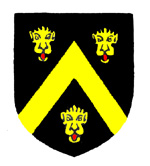The Manor of Westoning Younges

Wentworth family coat of arms
The first mention of the Manor of Westoning Younges is stated, by the Victoria County History for Bedfordshire, published in 1912, to be 1682. It was then held by Henrietta Maria, Baroness Wentworth, mistress of the Duke of Monmouth, along with Toddington Manor. She is supposed to have raised money to help her lover in his revolt against James II in 1685 which resulted in his execution that same year. Henrietta Maria escaped any retribution and died the following year.
The manor then passed to Henrietta Maria's great-aunt Anne, Lady Lovelace who released it to her son John, Lord Hurley in 1692. He died the following year and when his mother died in 1697 the manor passed to his daughter Martha, who became Baroness Wentworth in her own right. She held the manor jointly with her husband, Sir Henry Johnson in 1704. She died before her husband and on his death his daughter by another marriage Anne, wife of Thomas Wentworth, Earl of Strafford succeeded to the manor.
William son of the Earl and Anne died in 1791 and his property was divided amongst his three sisters, Ladies Anne Conolly, Lucy Howard and Harriet Vernon. All trace of the manor is lost after 1803.
There is a possibility that the seat of Younges manor may have been at Wood End, where a moat may be seen north of Wood End Farm - manor houses were often moated. The Bedfordshire Historic Environment Record [HER 232] notes that there is no sign of a building on the island of the moat, however. The description is as follows: "The site comprises the remains of a medieval moated enclosure, rectangular in shape, measuring approx 75 metres by 50 metres inclusive of the ditch, which is 11 metres wide. The moat is fed by a modern field drain at its south-west corner but the original source of water is thought to be a spring on the north arm of the moat. The island is flat with not indication of building locations or other features. The site may be associated with the remains of Wood End shrunken medieval village, which lie either side of the nearby road".